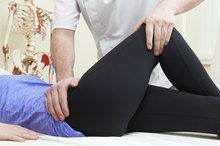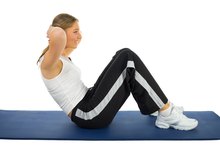Exercise Restrictions for Diastasis Recti in Men
Diastasis recti is an issue with the abdominal muscle. When diagnosed by your health provider, it means that the left and right side of your main abdominal muscle, the rectus abdominis, has separated. While this is common in pregnant women, it's also a potential muscular condition for men. When you have diastasis recti, you should avoid certain types of exercise to ensure the condition doesn't worsen.
Who's At Risk
Men who have had an abdominal aortic aneurysms repaired using an midline abdominal incision are most at risk for suffering diastasis recti, though it isn't clear if the surgery or the condition cause the separation. A study published in the December 2008 and January 2009 journal "Angioplasty" found that "diastasis recti are significantly more common in males with abdominal aortic aneurysm than peripheral arterial disease and may provide an important clue to screen for abdominal aortic aneurysm in those at risk."
Diagnosis
Signs & Symptoms of a Pulled Abdominal Muscle
Learn More
To ensure the condition in your abdomen is diagnosis recti, and not some other muscular or abdominal issue, your health provider will conduct a simple test. Lying down with legs bent, your health provider will ask you to raise your shoulder and head off the floor or mat. She will then feel your abdomen, about the level of your belly button, to see if a separation of more than three fingers exists. If it does, your rectus abdominis has separated, and you need to work to correct this common condition. In general, you can treat the condition relatively easily with few potential complications.
What to Avoid
Do not do leg lifts or curlups. While these typical abdominal exercises may strengthen an intact abdominal muscle, they will further exacerbate the separation of those who have diastasis recti. Any aggressive exercise that works the abdominal muscle will, in fact, make the separation worse, making recovery and repair more difficult.
Considerations
Celiac Artery Stenosis Symptoms
Learn More
Follow the guidelines established for post-partum women seeking to recover from the condition. Use gentle exercise to strengthen your abdominal muscles, not worsen the condition. Lying on your back, hold your abdominal muscles together, lift your head and contract your pelvis. Then lie back down and repeat until fatigued.
Related Articles
References
Writer Bio
Carolyn Williams began writing and editing professionally over 20 years ago. Her work appears on various websites. An avid traveler, swimmer and golf enthusiast, Williams has a Bachelor of Arts in English from Mills College and a Master of Business Administration from St. Mary's College of California.









